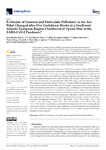Evolution of Gaseous and Particulate Pollutants in the Air: What Changed after Five Lockdown Weeks at a Southwest Atlantic European Region (Northwest of Spain) Due to the SARS-CoV-2 Pandemic?

Use este enlace para citar
http://hdl.handle.net/2183/27979
A non ser que se indique outra cousa, a licenza do ítem descríbese como Atribución 4.0 Internacional
Coleccións
- GI-QANAP - Artigos [30]
Metadatos
Mostrar o rexistro completo do ítemTítulo
Evolution of Gaseous and Particulate Pollutants in the Air: What Changed after Five Lockdown Weeks at a Southwest Atlantic European Region (Northwest of Spain) Due to the SARS-CoV-2 Pandemic?Autor(es)
Data
2021-04-27Cita bibliográfica
Moreda-Piñeiro, J.; Sánchez-Piñero, J.; Fernández-Amado, M.; Costa-Tomé, P.; Gallego-Fernández, N.; Piñeiro-Iglesias, M.; López-Mahía, P.; Muniategui-Lorenzo, S. Evolution of Gaseous and Particulate Pollutants in the Air: What Changed after Five Lockdown Weeks at a Southwest Atlantic European Region (Northwest of Spain) Due to the SARS-CoV-2 Pandemic? Atmosphere 2021, 12, 562. https://doi.org/10.3390/atmos12050562
Resumo
[Abstract] Due to the exponential growth of the SARS-CoV-2 pandemic in Spain (2020), the Spanish Government adopted lockdown measures as mitigating strategies to reduce the spread of the pandemic from 14 March. In this paper, we report the results of the change in air quality at two Atlantic Coastal European cities (Northwest Spain) during five lockdown weeks. The temporal evolution of gaseous (nitrogen oxides, comprising NOₓ, NO, and NO₂; sulfur dioxide, SO₂; carbon monoxide, CO; and ozone, O₃) and particulate matter (PM₁₀; PM₂․₅; and equivalent black carbon, eBC) pollutants were recorded before (7 February to 13 March 2020) and during the first five lockdown weeks (14 March to 20 April 2020) at seven air quality monitoring stations (urban background, traffic, and industrial) in the cities of A Coruña and Vigo. The influences of the backward trajectories and meteorological parameters on air pollutant concentrations were considered during the studied period. The temporal trends indicate that the concentrations of almost all species steadily decreased during the lockdown period with statistical significance, with respect to the pre-lockdown period. In this context, great reductions were observed for pollutants related mainly to fossil fuel combustion, road traffic, and shipping emissions (−38 to −78% for NO, −22 to −69% for NO₂, −26 to −75% for NOₓ, −3 to −77% for SO₂, −21% for CO, −25 to −49% for PM₁₀, −10 to −38% for PM₂․₅, and −29 to −51% for eBC). Conversely, O₃ concentrations increased from +5 to +16%. Finally, pollutant concentration data for 14 March to 20 April of 2020 were compared with those of the previous two years. The results show that the overall air pollutants levels were higher during 2018–2019 than during the lockdown period.
Palabras chave
SARS-CoV-2
Lockdown
Air quality
Gaseous and particulate matter pollutants
Lockdown
Air quality
Gaseous and particulate matter pollutants
Versión do editor
Dereitos
Atribución 4.0 Internacional
ISSN
2073-4433






